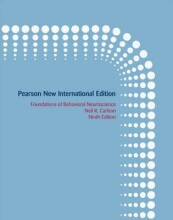Summary: Neuroscience. | 9780878936977 | Dale Purves
- This + 400k other summaries
- A unique study and practice tool
- Never study anything twice again
- Get the grades you hope for
- 100% sure, 100% understanding
Read the summary and the most important questions on Neuroscience. | 9780878936977 | edited by Dale Purves ... [et al.].
-
1 Studying the Nervous System
-
1.3 "Model" Organisms in Neuroscience
-
Why do we use different animals for studying the nervous system? Which animals do we examine?
All used animals have their own benefits and asssumptions.- Worm- Fruitfly- Zebra fish- Mice -
1.4 The Cellular Components of the Nervous System
This is a preview. There are 1 more flashcards available for chapter 1.4
Show more cards here -
What is the 'neuron doctrine'? (Sherrington, Golgi, Cajal)
Neurons form a continuous nerve cell network -
Name some methods that were used to study the nervous system.
First they used the light microscope and stained neurons with silver salt to study the nervous system. Later in the 1950's when the electric microscope appeared the research became clearer -
1.6 Neuroglial Cells
This is a preview. There are 2 more flashcards available for chapter 1.6
Show more cards here -
Name the function of glial cells.
- Recovery and development of neuronal networks- Maintaining the ionic milieu of neurons -
Where are Schwann cell located? In the periphery of CNS?
Schwann cells are nerve cells which are myelinated (enveloped by glia cell) and are located in the periphery -
What can be concluded out of the fact that the axons of interneurons are short?
Interneurons only participate in the local aspects of the circuit -
1.7 Cellular Diversity in the Nervous System
-
What is the Nissl method?
A method of staining the nervous system (blue) such stains demonstrate that the size, density and distriution of the total population of nerve cells is not uniform from region to region. -
What can be observed with antibody stains?
Antibody stains used on tissue can recognize specific proteins such as synapses and dendrites -
2 Electrical Signals of Nerve Cells
This is a preview. There are 11 more flashcards available for chapter 2
Show more cards here -
How can electrical signals of nerve cells be recorded?
Using an intracellular micro-electrode -
What are the 5 phases of the action potential?
Resting state: Na closed, K closed
Threshold: few Na open, K closed.
Depolarization: Na open, K closed
Repolarization: Na inactivated, K open
Undershoot: Na closed and inactivated, K slowly closing
- Higher grades + faster learning
- Never study anything twice
- 100% sure, 100% understanding
Topics related to Summary: Neuroscience.
-
Electrical Signals of Nerve Cells - How Ionic Movements Produce Electrical Signals
-
Synaptic Transmission - Diseases That Affect the Presynaptic Terminal
-
Neurotransmitters and Their Receptors
-
The Somatic Sensory System: Touch and Proprioception - Mechanoreceptros Specialized for Proprioception
-
The Somatic Sensory System: Touch and Proprioception - Mechanoreceptors Specialized for Proprioception
-
Vision: The Eye - Anatomy of the Eye
-
Vision: The Eye - The Formation of Images on the Retina
-
Vision: The Eye - Retinal Circuitry
-
Vision: The Eye - Functional Specialization of the Rod and Cones
-
Vision: The Eye - Cones and Color Vision
-
Vision: The Eye - Retinal Circuits for Detecting Luminance Change
-
Central Visual Pathways - Central Projections of Retinal Ganglion Cells
-
Central Visual Pathways - Visual Field Deficits
-
The Vestibular System - The Vestibular Labyrinth
-
The Vestibular System - Throwing Cold Water on The Vestibular System
-
Lower Motor Neuron Circuits and Motor Control - Overview
-
Lower Motor Neuron Circuits and Motor Control - The Spinal Cord Circuitry Underlying Muscle Stretch Reflexes
-
Upper Motor Neuron Control of the Brainstem and Spinal Cord
-
Modulation of Movement by the Basal Ganglia - Projections to the Basal Ganglia
-
Modulation of Movement by the Basal Ganglia - Projections from the Basal Ganglia to Other Brain Regions
-
Modulation of Movement by the Cerebellum - Organization of the Cerebellum
-
Modulation of Movement by the Cerebellum - Projections to the Cerebellum
-
Modulation of Movement by the Cerebellum - Projections from the Cerebellum
-
Modulation of Movement by the Cerebellum - Circuits within the Cerebellum
-
Early Brain Development - Overview
-
Early Brain Development - Formation of the major brain subdivisions

































